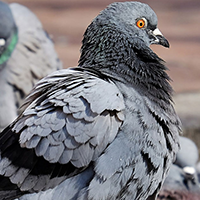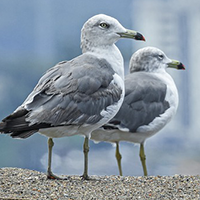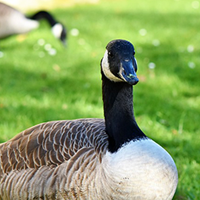By definition, Canada geese are not classified as pest birds and are afforded protection by Government agencies. Nonetheless, Canada Geese are one of the most recognizably large birds in southern Ontario, increasingly becoming the scourge of suburbia. Their numbers have grown in the past decade from only a few thousand to hundreds of thousands. The familiar V-shaped squadron of honking geese heading south is becoming a rare sight. Country Clubs and business parks offer pristinely manicured lawns and ponds, providing an ideal habitat and effectively modify their migration cycle. Geese are very opportunistic and readily exploit the 'easy living' conditions in urban environments. Hawkeye will provide you with the most effective solution to solve your goose control problem.
There are at least 10 or 11 subspecies of Canada geese, all similar in colour pattern, with a long black neck and head and large white cheek patches that meet under the throat. The bird's brown-gray body has a pale to dark breast and underparts, while the black tail has white upper and under tail coverts. The bill and feet are also black. The bird varies in size from 22 to 48 inches long and weighing in from 3 to 24 pounds.

Despite their ubiquitous presence, peaceful interactions between humans and geese are rare. Often, geese rip up grass lawns and leave feces everywhere. Not only is this unsightly, but goose feces has a high concentration of uric acid and can act as a corrosive agent, damaging buildings and machinery. Geese can also be aggressive and will attack people who unwittingly stray too close to their young. If you have unwanted geese on your property, Hawkeye will get rid of your goose problem permanently.
Most Common Scenarios and Complaints
Geese in golf courses and cemeteries
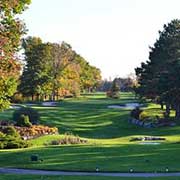 Some of the most common places for flocks of geese to congregate are golf courses and cemeteries. The neatly kept grass lawns are an attractant: geese feed on young shoots that grow especially well when the grass is regularly mowed. Both locations are also usually somewhat secluded and offer protection and distance from heavy human traffic. Finally, there is typically a water source nearby, such as ponds or water hazards, where geese can gain refuge from land predators. Unfortunately, humans also use these spaces, and conflicts with geese can be frightening and dangerous. These areas are also designed with aesthetics in mind, so the large amounts of feces left by flocks of geese are very unsightly.
Some of the most common places for flocks of geese to congregate are golf courses and cemeteries. The neatly kept grass lawns are an attractant: geese feed on young shoots that grow especially well when the grass is regularly mowed. Both locations are also usually somewhat secluded and offer protection and distance from heavy human traffic. Finally, there is typically a water source nearby, such as ponds or water hazards, where geese can gain refuge from land predators. Unfortunately, humans also use these spaces, and conflicts with geese can be frightening and dangerous. These areas are also designed with aesthetics in mind, so the large amounts of feces left by flocks of geese are very unsightly.
Geese in city parks
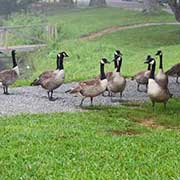 City parks often offer the same grass fields, relative seclusion, and water sources that golf courses and cemeteries do, but they provide additional challenges as well. As parks are public places, there is more human foot traffic and therefore more conflicts with geese. Bird control can be difficult in these situations, as city parks are a system of green spaces, and keeping geese out of one park may just move them to the next park over. This is especially true with parks on the waterfront, where geese can bounce from one area to another to avoid threats but never actually have to leave the system. Getting rid of geese in this situation requires a more concentrated effort where persistence is key. Read more about Mitigating Geese in Parks and on Beaches »
City parks often offer the same grass fields, relative seclusion, and water sources that golf courses and cemeteries do, but they provide additional challenges as well. As parks are public places, there is more human foot traffic and therefore more conflicts with geese. Bird control can be difficult in these situations, as city parks are a system of green spaces, and keeping geese out of one park may just move them to the next park over. This is especially true with parks on the waterfront, where geese can bounce from one area to another to avoid threats but never actually have to leave the system. Getting rid of geese in this situation requires a more concentrated effort where persistence is key. Read more about Mitigating Geese in Parks and on Beaches »
Geese in agricultural fields
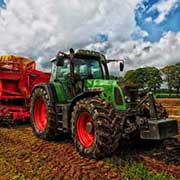 Geese cause a lot of problems in agricultural fields. In crop fields, the birds are attracted to the new growth of the plants and the waste grains. Because this provides the geese with a constant source of food, it takes quite a bit of work to drive them away. However, the setting of agricultural areas can be beneficial to the cause of goose control, as the remoteness of farms and the rural jurisdiction often allow for more intrusive or visible control methods to be employed safely and discreetly.
Geese cause a lot of problems in agricultural fields. In crop fields, the birds are attracted to the new growth of the plants and the waste grains. Because this provides the geese with a constant source of food, it takes quite a bit of work to drive them away. However, the setting of agricultural areas can be beneficial to the cause of goose control, as the remoteness of farms and the rural jurisdiction often allow for more intrusive or visible control methods to be employed safely and discreetly.
Geese around airports
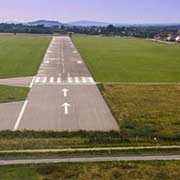
Another major area of concern is geese at or around airports. Large flocks of geese in the airspace and immediate areas around an airport create a risk of hitting and damaging incoming or outgoing aircraft. Birdstrikes are extremely dangerous for both geese and humans, as well as costly in terms of damage to equipment. In fact, it was a flock of geese that caused the birdstrike with Flight 1549 and forced the plane to land on the Hudson River. Many aircraft collisions with geese do not end in such miraculous saves.
However, because airports are frequently on the outskirts of the city or in more rural areas, a greater range of bird control methods may be used without disturbing the general public or nearby residents.
CWS Migratory Bird Permit
Do I need a permit to remove geese from my property?
Canada geese are protected under the Migratory Birds Convention Act 1994, and therefore most actions taken to deter them from properties require a Canadian Wildlife Service (CWS) Migratory Bird Permit. The best time to obtain a permit is in January and February because they can often take a while for CWS to process. Hawkeye will obtain the permits on your behalf to ensure that bird control can proceed in the most efficient way. Read more about obtaining a permit here »
How do I obtain a permit?
The time to get started on a permit is in January and February. We can obtain the appropriate CWS permit on your behalf. Read more about obtaining a permit here »
Geese Control Methods and Solutions
Falconry
Falconry uses birds of prey, like hawks, falcons, and especially eagles, to chase geese from the air. Geese are extremely frightened of eagles and have the same reaction to one as humans do when someone yells "Shark!": they scatter. Further, because the raptors are actively chasing the geese, the geese will not habituate and will have the same reaction every time. Though this is one of the labour intensive methods of goose control due to the high level of expertise needed to work with the birds of prey, it is also by far the most effective.
Dogs
Dogs are often used to chase geese and scare them from the ground. Like the raptors, the dogs represent an active threat to the geese, meaning that they will never get used to it. However, due to safety concerns, dogs cannot be used in some environments, like rooftops. Chasing geese with dogs is the most common goose control method on the ground and one of the most effective in many situations
Remote Operated Vehicles (ROVs)
ROVs are used to chase geese where it would be inconvenient or impossible for a dog or human to do so. Different types of drones are used to chase geese in the air, land, or water. Unfortunately, the technology can be fragile and easily lost, especially when in the water. ROVs can be very effective in large bodies of water where geese can easily float or fly to the other side before the dogs can swim to them. Therefore, Hawkeye typically uses birds of prey, dogs, and ROVs together to chase geese away effectively.
Pyrotechnics
Hawkeye uses the firing of cracker shells, called bangers and screamers, that create loud sounds and bright firework-like visual displays to scare away the birds. The sounds and lights are startling and give the geese an extra push from the property. However, pyro is prohibited in some jurisdictions and is disruptive to nearby residents. Further, because the loud sounds do not harm the geese, they will eventually habituate.
Therefore, Hawkeye uses pyrotechnics in conjunction with other scaring techniques for the best results.
Lasers
Hawkeye uses high-powered industrial-strength lasers to scare away geese. When the laser is shone on the ground around a goose’s feet, the bird is frightened: they do not know what it is, as there is nothing similar to a laser in nature. The laser is especially effective in scaring away geese. It is a much lower profile solution than chasing the geese or using pyro but requires a trained operator to be consistently stationed on the property. Additionally, some jurisdictions do not allow the use of high-powered lasers because of their effect on aircraft.
Hunting
In some areas, such as rural districts, Canada geese may be hunted with firearms. Hawkeye will obtain the permits to hunt them in areas where the discharge of firearms is otherwise prohibited. This is a very effective and highly regulated method of getting rid of geese: what is killed can never return. However, this is a very high-profile method of geese removal, and animal activists may object.
Any scaring method that uses firearms, birds of prey, and aircraft requires a federal permit from Environment Canada. Any scaring technique that can result in a goose's injury or death also requires a kill permit.
Egg Oiling
Egg sterilization by chemical oiling involves coating the eggs in vegetable or mineral oil to prevent the birds from hatching. Because no geese are born within the nesting period, there will be fewer birds on the property for the rest of the season. As the population does not replenish itself, fewer birds will be alive to return next year. This, however, is quite a labour-intensive and ineffective method of long-term goose control. For one, the geese will continue to incubate the eggs for as long as they think they are viable, up to six weeks after the eggs are oiled, and therefore will still be an aggressive presence on your property. Furthermore, this does not deter the geese from returning next year to lay their eggs again. If not properly oiled, the eggs may still hatch, and deformed geese can be born; thus, a trained professional must do this job. Additionally, oiling the eggs requires as many as 20 visits per month over the two nesting months. Finally, geese may track the oil into nearby water sources, which can damage the environment. Keep in mind that this process is considered egg destruction and requires a permit from Environment Canada to perform.
Egg Destruction and Nest Removal
A more effective and much less complicated method is egg destruction and nest removal. When their eggs are destroyed, the geese have no reason to stay through the nesting period and will move on. Because the geese are no longer protecting nests, they become much less aggressive and can be more easily chased away. Moreover, the geese will learn to stay away from this property in subsequent years, as they have learned that this nesting site represents a threat to their eggs. This method of bird control requires a permit as well.
Frequently Asked Questions
When do geese become a problem?
- Spring: You'll find geese congregate and aggressively protect their nests and young from March until May.
- Summer: Moulting geese will gather in large flocks from June until late July.
What time of year do geese become a problem?
Geese typically gather in large groups two times a year: when they are nesting and moulting. Nesting season begins in March when geese will pair up and choose a territory. From March through May, geese will be protecting their eggs and consequently become very aggressive. Additionally, geese moult out their flight feathers and grow new ones once a year, leaving them flightless for 4 to 6 weeks, from June to late July. Non-breeding adults will gather in large flocks and pick an area to remain for the remainder of their moult. Unfortunately, due to climate change in Canada, flocks of geese stay longer before migrating south, with some flocks migrating not very far at all.
Are geese dangerous?
In some cases, yes. While nesting, geese become very aggressive and can easily harm an animal or small child. Further, goose feces contains dangerous bacteria and parasites that cause serious illness in humans. Children often come into contact with goose feces when playing in the water or on the ground.
What can we do once geese have already nested?
From April onwards, geese will have already nested, and it becomes almost impossible to scare them away. Hawkeye can use multiple methods to interfere with their nests and eggs. These are called lethal management strategies, and permits restrict the number of eggs and nests eligible for destruction based on geese's current population in certain areas.
What can we do about moulting flocks that have already settled into an area?
Once a moulting flock has gathered and settled into an area, it is very difficult and illegal to scare them away, as they cannot fly. So, Hawkeye can relocate the flocks. Moulting geese can be safely rounded up and transported to a more suitable location. Hawkeye typically moves them 300 to 400 km away, so there is no chance of returning within the season. This method can sometimes deter them from returning in subsequent years. However, it is a significant operation that requires trained individuals, which will increase the service price. Read more about Geese Relocation »
What scares geese away?
Only the consistent presence of predators, like birds of prey and dogs, will scare geese. Any other product or system becomes completely ineffective, as the geese will quickly habituate.
How can I scare geese away from my property?
Once a flock of geese has settled in an area to nest or moult, it can be almost impossible to scare them away. Nesting geese are protective of their young and attached to the nesting site: they will not abandon them. Moulting flocks are flightless, and therefore cannot fly away when threatened. Preventing flocks from settling in an area using scaring methods is the most effective way to keep them off of your property for the duration of the season. There are multiple ways to scare geese, but all of them require someone to be consistently present on the property to scare the geese away every time they show up. Hawkeye will have to return anywhere from 2 to 7 times a week to ensure that the geese are scared away until they have decided to nest elsewhere. Once we get started, we often see results quite quickly.
Can you legally kill geese?
Depending on the jurisdiction, the answer may be different. When necessary, Hawkeye will obtain the permits required to kill geese with firearms.
What attracts geese to my property?
Geese are attracted to frequently-mowed grass lawns and open sources of water, such as ponds or lakes.
Other common pest birds are Cormorants, Crows, Ducks, Doves, Grackels, Seagulls, Pigeons, Robins, Sparrows and Starlings.
Summary: Geese can be a very aggravating and even dangerous problem. Hawkeye will work with you to assess your situation and make recommendations on the best course(s) of action to guarantee the best results. We ensure effective goose removal in all cases and continue working with you until all geese are gone.














